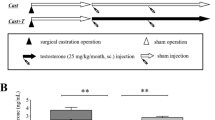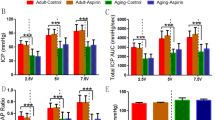Abstract
Some studies suggest that high-estrogen levels lead to erectile dysfunction (ED); high-estrogen levels are known to decrease testosterone levels. However, no study has examined whether testosterone replacement can improve the ED induced by high-estrogen levels. We investigated the effects of testosterone on ED caused by high-estrogen levels in rats. Rats were distributed in the following groups: (1) control (vehicle for 2 weeks), (2) the estrogen-treated group (ES; estradiol (3 μg kg−1 day−1) for 2 weeks), and (3) the estrogen- and testosterone-treated group (ES+TE; estradiol (3 μg kg−1 day−1) and testosterone (3 mg kg−1 day−1) for 2 weeks). We measured smooth muscle function via isometric tension and erectile function by measuring the intracavernosal pressure on cavernous nerve stimulation. In the ES group, the contraction of the corpus cavernosum smooth muscle increased in response to noradrenalin, and its relaxation decreased in response to the nitric oxide donor, sodium nitroprusside. Further, the erectile function was significantly decreased. In the ES+TE group, neither smooth muscle function nor erectile function was significantly improved. In conclusion, a high-estrogen milieu affected erectile function in rats, and testosterone treatment did not improve the ED caused by high-estrogen levels.
This is a preview of subscription content, access via your institution
Access options
Subscribe to this journal
Receive 8 print issues and online access
$259.00 per year
only $32.38 per issue
Buy this article
- Purchase on Springer Link
- Instant access to full article PDF
Prices may be subject to local taxes which are calculated during checkout





Similar content being viewed by others
References
Shamloul R, Ghanem H . Erectile dysfunction. Lancet 2013; 381: 153–165.
Keller J, Chen YK, Lin HC . Hyperthyroidism and erectile dysfunction: a population-based case-control study. Int J Impot Res 2012; 24: 242–246.
Andersen ML, Santos-Silva R, Bittencourt LR, Tufik S . Prevalence of erectile dysfunction complaints associated with sleep disturbances in Sao Paulo, Brazil: a population-based survey. Sleep Med 2010; 11: 1019–1024.
Shaeer O, Shaeer K . The Global Online Sexuality Survey (GOSS): The United States of America in 2011. Chapter I: Erectile dysfunction among English-speakers. J Sex Med 2012; 9: 3018–3027.
Basar MM, Aydin G, Mert HC, Keles I, Caglayan O, Orkun S et al. Relationship between serum sex steroids and aging male symptoms score and international index of erectile function. Urology 2005; 66: 597–601.
Greco EA, Pili M, Bruzziches R, Corona G, Spera G, Aversa A . Testosterone:estradiol ratio changes associated with long-term tadalafil administration: a pilot study. J Sex Med 2006; 3: 716–722.
Srilatha B, Adaikan PG, Chong YS . Relevance of oestradiol-testosterone balance in erectile dysfunction patients’ prognosis. Singapore Med J 2007; 48: 114–118.
Srilatha B, Adaikan PG . Endocrine milieu and erectile dysfunction: is oestradiol-testosterone imbalance, a risk factor in the elderly? Asian J Androl 2011; 13: 569–573.
Goyal HO, Braden TD, Williams CS, Williams JW . Estrogen-induced developmental disorders of the rat penis involve both estrogen receptor (ESR)- and androgen receptor (AR)-mediated pathways. Biol Reprod 2009; 81: 507–516.
Simon L, Avery L, Braden TD, Williams CS, Okumu LA, Williams JW et al. Exposure of neonatal rats to anti-androgens induces penile mal-developments and infertility comparable to those induced by oestrogens. Int J Androl 2012; 35: 364–376.
Adaikan PG, Srilatha B . Oestrogen-mediated hormonal imbalance precipitates erectile dysfunction. Int J Impot Res 2003; 15: 38–43.
Srilatha B, Adaikan PG . Estrogen and phytoestrogen predispose to erectile dysfunction: do ER-alpha and ER-beta in the cavernosum play a role? Urology 2004; 63: 382–386.
Hotta Y, Hattori M, Kataoka T, Ohno R, Mikumo M, Maeda Y et al. Chronic vardenafil treatment improves erectile function via structural maintenance of penile corpora cavernosa in rats with acute arteriogenic erectile dysfunction. J Sex Med 2011; 8: 705–711.
Hotta Y, Ohno R, Kataoka T, Mikumo M, Takahata Y, Ohno M et al. Effects of chronic vardenafil treatment persist after end of treatment in rats with acute arteriogenic erectile dysfunction. J Sex Med 2012; 9: 1782–1788.
Honma S, Kawabe K, Misawa M, Okuyama M, Kumagaya M, Okazaki Y . Simple method for the estimation of bio-available testosterone in serum. Clin Endocrinology 2004; 52: 829–844.
Yamashita K, Okuyama M, Watanabe Y, Honma S, Kobayashi S, Numazawa M . Highly sensitive determination of estrone and estradiol in human serum by liquid chromatography-electrospray ionization tandem mass spectrometry. Steroids 2007; 72: 819–827.
Ma H, Chung MH, Lu Y, Nishihara T, Hattori M . Estrogenic effects of the herbal formula, menoprogen, in ovariectomized rats. Biol Pharm Bull 2010; 33: 455–460.
Morelli A, Chavalmane AK, Filippi S, Fibbi B, Silvestrini E, Sarchielli E et al. Atorvastatin ameliorates sildenafil-induced penile erections in experimental diabetes by inhibiting diabetes-induced RhoA/Rho-kinase signaling hyperactivation. J Sex Med 2009; 6: 91–106.
Jin L, Liu T, Lagoda GA, Champion HC, Bivalacqua TJ, Burnett AL . Elevated RhoA/Rho-kinase activity in the aged rat penis: mechanism for age-associated erectile dysfunction. FASEB J 2006; 20: 536–538.
Fibbi B, Filippi S, Morelli A, Vignozzi L, Silvestrini E, Chavalmane A et al. Estrogens regulate humans and rabbit epididymal contractility through the RhoA/Rho-kinase pathway. J Sex Med 2009; 6: 2173–2186.
Villalba N, Contreras C, Hernández M, García-Sacristán A, Prieto D . Impaired Ca2+ handling in penile arteries from prediabetic Zucker rats: involvement of Rho kinase. Am J Physiol Heart Circ Physiol 2011; 300: 2044–2053.
Nunes KP, Rigsby CS, Webb RC . RhoA/Rho-kinase and vascular diseases: what is the link? Cell Mol Life Sci 2010; 67: 3823–3836.
Linder AE, Dorrance AM, Mills TM, Webb RC, Leite R . Erectile function in two-kidney, one-clip hypertensive rats is maintained by a potential increase in nitric oxide production. J Sex Med 2009; 6: 279–285.
Li WJ, Park K, Paick JS, Kim SW . Chronic treatment with an oral rho-kinase inhibitor restores erectile function by suppressing corporal apoptosis in diabetic rats. J Sex Med 2011; 8: 400–410.
Hannan JL, Albersen M, Kutlu O, Gratzke C, Stief CG, Burnett AL et al. Inhibition of Rho-kinase improves erectile function, increases nitric oxide signaling and decreases penile apoptosis in a rat model of cavernous nerve injury. J Urol 2012; 189: 1155–1161.
Saito M, Ohmasa F, Dimitriadis F, Tsounapi P, Sejima T, Shimizu S et al. Hydroxyfasudil ameliorates penile dysfunction in the male spontaneously hypertensive rat. Pharmacol Res 2012; 66: 325–331.
Kley HK, Niederau C, Stremmel W, Lax R, Strohmeyer G, Krüskemper HL . Conversion of androgens to estrogens in idiopathic hemochromatosis: comparison with alcoholic liver cirrhosis. J Clin Endocrinol Metab 1985; 61: 1–6.
Williams G . Aromatase up-regulation, insulin and raised intracellular oestrogens in men, induce adiposity, metabolic syndrome and prostate disease, via aberrant ER-α and GPER signalling. Mol Cell Endocrinol 2012; 351: 269–278.
Pasco JA, Nicholson GC, Brennan SL, Kotowicz MA . Prevalence of obesity and the relationship between the body mass index and body fat: cross-sectional, population-based data. PLoS One 2012; 7: e29580.
Feldman HA, Goldstein I, Hatzichristou DG, Krane RJ, McKinlay JB . Impotence and its medical and psychosocial correlates: results of the Massachusetts Male Aging Study. J Urol 1994; 151: 54–61.
Buvat J, Maggi M, Gooren L, Guay AT, Kaufman J, Morgentaler A et al. Endocrine aspects of male sexual dysfunctions. J Sex Med 2010; 7: 1627–1656.
Esposito K, Giugliano F, Martedì E, Feola G, Marfella R, D'Armiento M et al. High proportions of erectile dysfunction in men with the metabolic syndrome. Diabetes Care 2005; 28: 1201–1203.
Ryan JG, Gajraj J . Erectile dysfunction and its association with metabolic syndrome and endothelial function among patients with type 2 diabetes mellitus. J Diabetes Complications 2012; 26: 141–147.
Corona G, Mannucci E, Fisher AD, Lotti F, Petrone L, Balercia G et al. Low levels of androgens in men with erectile dysfunction and obesity. J Sex Med 2008; 5: 2454–2463.
Corona G, Monami M, Rastrelli G, Aversa A, Tishova Y, Saad F G et al. Testosterone and metabolic syndrome: a meta-analysis study. J Sex Med 2011; 8: 272–283.
Yassin A, Saad F, Gooren LJ . Metabolic syndrome, testosterone deficiency and erectile dysfunction never come alone. Andrologia 2008; 40: 259–264.
Shabsigh R, Arver S, Channer KS, Eardley I, Fabbri A, Gooren L et al. The triad of erectile dysfunction, hypogonadism and the metabolic syndrome. Int J Clin Pract 2008; 62: 791–798.
Diaz-Arjonilla M, Schwarcz M, Swerdloff RS, Wang C . Obesity, low testosterone levels and erectile dysfunction. Int J Impotence Res 2009; 21: 89–98.
Boloña ER, Uraga MV, Haddad RM, Tracz MJ, Sideras K, Kennedy CC et al. Testosterone use in men with sexual dysfunction: a systematic review and meta-analysis of randomized placebo-controlled trials. Mayo Clin Proc 2007; 82: 20–28.
Mäkinen JI, Huhtaniemi I . Androgen replacement therapy in late-onset hypogonadism: current concepts and controversies—a mini-review. Gerontology 2011; 57: 193–202.
Author information
Authors and Affiliations
Corresponding author
Ethics declarations
Competing interests
The authors declare no conflict of interest.
Rights and permissions
About this article
Cite this article
Kataoka, T., Hotta, Y., Ohno, M. et al. Limited effect of testosterone treatment for erectile dysfunction caused by high-estrogen levels in rats. Int J Impot Res 25, 201–205 (2013). https://doi.org/10.1038/ijir.2013.21
Received:
Revised:
Accepted:
Published:
Issue Date:
DOI: https://doi.org/10.1038/ijir.2013.21
Keywords
This article is cited by
-
Estrogenic endocrine disruptor exposure directly impacts erectile function
Communications Biology (2024)
-
Aqueous extract of Lespedeza cuneata improves male menopause by increase of nitric oxide and dihydrotestosterone
Food Science and Biotechnology (2019)



